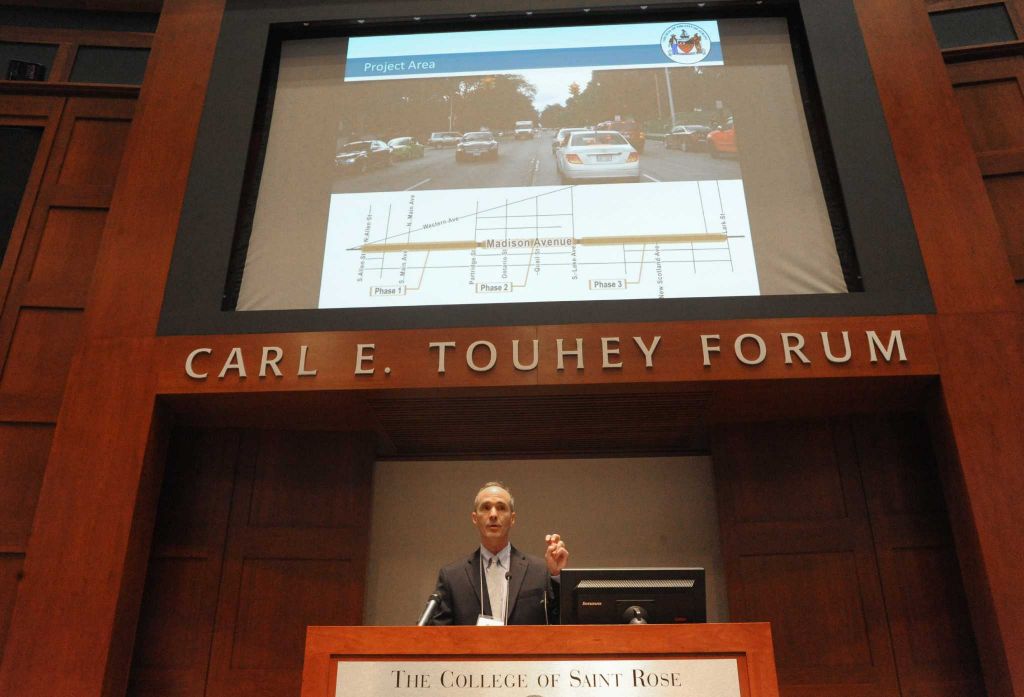Mark Sargent of Creighton Manning Engineering talks about the Madison Avenue road diet plans for bicycle accommodations during an open forum at the College of Saint Rose on Wednesday July 29, 2015 in Albany, N.Y. (Michael P. Farrell/Times Union)
City leaders want to put Madison Avenue on a diet, trimming the number of driving lanes and making the road friendlier to bicyclists.
But like any diet, it’s not necessarily easy. The more attractive options — protected lanes to make all riders comfortable and safe — are more costly to install and to maintain.
On Wednesday, the public reviewed and gave their input on five alternatives for the future design of the road at a public meeting at the Touhey Forum in the Lally School of Education at The College of Saint Rose. The options varied from simply putting in road markings to indicate cars and bikes should share the road — the least popular option — to protected lanes that keep bikes and cars completely separated.
And there were options in the middle, like dedicated bike lanes with buffer zones but without barriers between four-wheeled vehicles and two-wheeled ones.
“It’s most important we get it right,” said Mayor Kathy Sheehan at the meeting’s start. “This will become the model for what we do in other parts of the city.”
The city seeks to redo the road from South Allen to Lark streets, a 1.6-mile stretch that sees 15,000 cars daily. The first phase, from South Allen to Partridge Street, is planned for next year, with the rest done in two phases.
Madison Avenue now has four lanes — two in each direction.
The first and least popular option presented Wednesday was one driving lane in each direction with a central turning lane, and the road painted to show that cars and bikes should share the road. The lanes would be 14 feet wide, but that could actually speed up traffic.
While no attendee much liked that idea, several options got support. After a review of the options and question period, residents stuck dots on posters describing each of the options to show which ones they liked and disliked.
One option was to have conventional bike lanes with no barrier, which leave riders vulnerable to both moving vehicles and drivers parking and then opening their car doors into riders’ paths.
A third choice was to have parking on one side of the road and separated bike lanes on the other, with one bike lane in each direction on the same side of the road. Each bike lane would be 4 feet wide, tighter than some other options, but riders would then be clear of both moving traffic and parked cars.
The city also could put in bike lanes on either side of the road, physically separated from cars. The city would have to buy special equipment to clear snow from bike lanes, or it could opt to shut them down until snow is removed.
The final choice was a buffered bike lane without a concrete barrier. It would have 3 feet marked off between cars and the bike lanes.
Some options had a center turning lane all down Madison Avenue while others had the turning lane eliminated in the middle of blocks.
Josh and Rebecca Caldon of Albany came with their three children, Zeke, 10, and twins Ian and Isaac, 7. The couple said they liked the idea of two lanes for cars with a center turning lane, with bicyclists in their own lanes separated from cars but without the barrier.
“It gives enough space for the cyclist but doesn’t take any parking,” she said.
Some residents raised concern about the potential loss of parking and impact on traffic.
Kyle Caffrey said he moved to Albany from New York City, where residents aired similar concerns. When protected bike lanes were created there, he said, those worries proved to be for naught.
“The increase in cyclists was amazing,” he said.
Albany Times Union Wednesday – July 29, 2015 by Tim O’Brien

